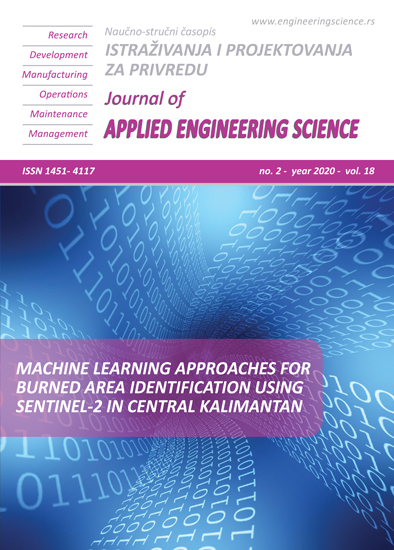JUSTIFICATION OF EVALUATION CRITERIA OF GOLD BENEFICIATION ABILITY BY GRAVITATIONAL METHODS
Abstract
The development of science and technology involves the use of specialized software packages designed, among other things, for mathematical modeling and simulation of enrichment processes. One of the goals of using this type of software is to optimize technological treatment processes, design of processing plants, etc. However, since the corresponding software is not always freely available, or it does not exist, there is a need to develop application tools. The objective is to study the application of object-oriented programming to evaluate the enrichment of raw materials by gravitational methods. This paper presents the results of mathematical modeling of the gravitational separation of a mixture of polymineral gold-pyrite, gold-quartz, and gold-arsenopyrite intergrown pieces. The obtained alignment charts allow estimating the enrichment of raw materials depending on the unlocking degree of intergrown pieces. As a result of the study, a criterion was proposed to evaluate the possibility of gravitational grain separation, grain size, and unlocking degree. A chart for evaluating the possibility of gravitational separation was proposed.
References
2. Myazin V.P., & Litvintsev S.A. (2018). Increasing the efficiency of gravity extraction of gold from complex gold-polymetallic ores. Proceedings of the Siberian Branch of the Section of Earth Sciences of the Russian Academy of Natural Sciences. Geology, exploration and development of mineral deposits. Vol. 41. - No. 1 (62).
3. Algebraistova, N.K., Samorodskiy, P.N., Kolotushkin, D.M., & Prokopyev, I.V. (2018). Technology of gold recovery from gold-bearing technogenic raw materials. Obogashchenie Rud, (1), pp. 33-37.
4. Mkandawire, N.P., McGrath, T., Bax, A., Eksteen, J. Potential of the dense media cyclone for gold ore preconcentration (2020) Mineral Processing and Extractive Metallurgy: Transactions of the Institute of Mining and Metallurgy, 129 (1), pp. 87-95
5. Verkhoturov M.V. (2006). Gravity methods of enrichment. Textbook. for a university. M .: MAKS Press. Pp. 352.
6. Lvov V., Sishchuk J., & Chitalov L. (2017). Intensification of Bond ball mill work index test through various methods. International Multidisciplinary Scientific GeoConference: SGEM: Surveying Geology & mining Ecology Management. Vol. 17. – №. 1.1. – Pp. 857-863.
7. Nikolaeva, N.V., Taranov, V.A., & Afanasova, A.V. (2015). Ore strength analysis in planning ore pretreatment circuit Information about author. Gornyi Zhurnal, 2015 (12), pp. 9-13.
8. Algebraistova, N.K., Makshanin, A.V., Burdakova, E.A., Samorodskiy, P.N., & Markova, A.S. (2015). Development of stage gravity flowsheet for recovery of noble metals, Obogashchenie Rud, (2), pp. 3-7.
9. Wills B. A., & Finch J. (2019). Wills' mineral processing technology: an introduction to the practical aspects of ore treatment and mineral recovery. – Butterworth-Heinemann, 2015.
10. Wang, X., Qin, W., Jiao, F., Yang, C., Cui, Y., Li, W., Zhang, Z., Song, H. Mineralogy and pretreatment of a refractory gold deposit in Zambia (2019) Minerals, 9 (7), № 406, .
11. Lowes, Callan & Zhou, J & Galvin, Kevin. (2018). Gravity Separation of Gold Ore using the REFLUX™ Classifier to Achieve Coarse Particle Gangue Rejection. Chemeca. Pp. 74.
12. Vasiliev A. M. (2011). Analysis of formulas for the free fall velocity of spherical particles. Ore dressing. No. 2. - Pp. 22-26.
13. Matveev, I.A., Matveev, A.I., Eremeeva, N.G., & Grigorev, Y.M. (2018). Experimental and theoretical investigation of the behavior of particles in water flow. Mining Informational and Analytical Bulletin, (11), pp. 171-177.
14. Aleksandrova T.N. & Kuskov V.B. (2014). Development of methods for increasing efficiency of gravitational extraction of small and thin gold from scales of different genesis. Journal of Mining Institute. Vol. 210, p. 69-77.
15. Stival, M., Cunha, E. J. N. S., Cunha, M., & Rocha, J. R. C. D. (2019). Application of ludic activity for learning of chemical concepts: Case study. [Aplicação de atividade lúdica para o aprendizado de conceitos químicos: Estudo de caso] Periodico Tche Quimica, 16(32), 783-793.
16. Teles, A. C., Freitas, A. C. D. P., & Rodrigues, A. C. (2019). Failures detection methods in chemical process using artificial intelligence. [Comparação de métodos de detecção de falhas em processos químicos utilizando inteligência artificial] Periodico Tche Quimica, 16(32), 61-68.

